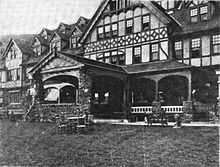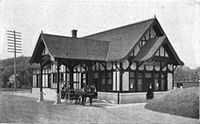Porte-cochère


A porte-cochère (/ˌpɔːrt koʊˈʃɛr/), coach gate or carriage porch is a porch- or portico-like structure at a main or secondary entrance to a building through which a horse and carriage (or motor vehicle) can pass in order for the occupants to alight under cover, protected from the weather.
In modern usage, porte-cochères are still used on some types of buildings such as major public buildings and hotels, where they provide pick-up and drop-off space, for example for dignitaries, taxis and buses.
History
The porte-cochère was a feature of many late 18th- and 19th-century mansions and public buildings. Well-known examples are at Buckingham Palace in London and at the White House in Washington D.C. Today a porte-cochère is often constructed at the entrance to public buildings such as churches, hotels, health facilities, homes, and schools where people are delivered by other drivers. Porte-cochères differ from carports in which vehicles are parked; at a porte-cochère the vehicle can pass through, stopping for passengers to board or alight.
At the foot of the porte-cochère there are often guard stones, which act as protective bollards to prevent vehicles from damaging the structure.
Gallery
-
The Lockwood–Mathews Mansion, built in 1864
-

The Briarcliff Lodge, built in 1902
-

The Briarcliff Manor railroad station, built in 1906
-

A typical railway porte-cochere at Nottingham station
References
External links
| Wikimedia Commons has media related to Portes-cochères. |
| Look up porte cochère in Wiktionary, the free dictionary. |
| ||||||||||||||||||||||||||||||
